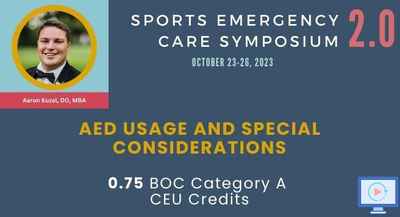Course Info (BOC Domains of Athletic Training; Presentation Description; Learning Objectives; Clinical Practice Gap Statement; Clinical Bottom Line; Summary Conclusions)
BOC Domains of Athletic Training:
-
Domain I - Risk Reduction, Wellness, and Health Literacy
-
Domain II - Clinical Evaluation and Diagnosis
-
Domain Ill - Critical Incident Management
- Domain IV - Healthcare Administration and Professional Responsibility
Presentation Description:
AEDs are vital tools in cardiac emergencies. This presentation covers AED features, functions, and necessary precautions. We'll emphasize the "push hard and push fast" approach to CPR, safety measures, and the significance of AED maintenance, training, and medical direction. Special considerations, including patients with cardiac devices, and automated chest compression devices, will also be addressed.
Learning Objectives:
- Describe features, functions, and precautions related to AEDs.
- Explain the "push hard and push fast" approach to CPR.
- Discuss safety precautions in resuscitation situations.
- Explain the importance of AED maintenance, training, and medical direction.
- Discuss special considerations with AED usage in patients with cardiac devices.
- Compare advantages and disadvantages of automated chest compression devices.
Revised Clinical Practice Gap Statement:
Despite AEDs being more commonplace in athletic facilities, many athletic trainers may not possess comprehensive knowledge about their operation and specific features, which can result in delayed or ineffective resuscitation. This lack of understanding extends to the importance of rigorous AED maintenance, specialized training, and medical guidance, potentially jeopardizing patient outcomes in cardiac emergencies.
Revised Clinical Bottom Line Statement:
For athletic trainers, having an in-depth understanding of AED functionality, effective CPR techniques like the "push hard and push fast" approach, and relevant safety protocols is imperative. This expertise, combined with awareness of the significance of AED maintenance, specialized training, and medical direction, enables athletic trainers to maximize the effectiveness of resuscitation efforts in sports-related settings.
Revised Summary Conclusion Statements:
- In-depth knowledge of AED capabilities and safety measures enhances their effective deployment.
- Adopting the "push hard and push fast" strategy for CPR can significantly improve the odds of successful resuscitation.
- Regular AED maintenance and appropriate training under medical direction are essential for the device's optimal functionality.
- Special cases, such as patients with cardiac devices, require distinct considerations to safely utilize AEDs in athletic contexts.


